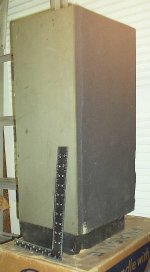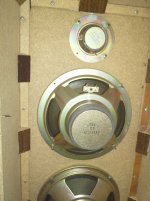Someone gave me a pair of Kenwood (Trio) loudspeakers - 1980s, typical Japanese rack system style floorstanders, but not the Kabuki style.
The cabinets (plastic veneer MDF) are extremely badly bashed about, although the drivers are very OK (6" driver, 6" passive cone, 1" tweeter). Non-removable front fabric, which is probably what saved the drivers. The cones have a polymer impregnated fabric surround - I like that! - so they have not deteriorated at all.
I was thinking I could make something quite pretty with real wood veneer, using the drivers, and much heavier and less resonant using substantially thicker MDF.
Any thoughts on cabinet re-design though? Should I follow the original cabinet dimensions exactly, or are there advantages to redimensioning things? Since I have no data on the actual drivers and passive radiators, calculations are rather iffy.
Basically what I'm wondering is... when companies like Kenwood made this type of speaker, did they really do all the correct design calculations, or did they just stick arbitrary drivers in boxes to meet a specific aesthetic goal?
The cabinets (plastic veneer MDF) are extremely badly bashed about, although the drivers are very OK (6" driver, 6" passive cone, 1" tweeter). Non-removable front fabric, which is probably what saved the drivers. The cones have a polymer impregnated fabric surround - I like that! - so they have not deteriorated at all.
I was thinking I could make something quite pretty with real wood veneer, using the drivers, and much heavier and less resonant using substantially thicker MDF.
Any thoughts on cabinet re-design though? Should I follow the original cabinet dimensions exactly, or are there advantages to redimensioning things? Since I have no data on the actual drivers and passive radiators, calculations are rather iffy.
Basically what I'm wondering is... when companies like Kenwood made this type of speaker, did they really do all the correct design calculations, or did they just stick arbitrary drivers in boxes to meet a specific aesthetic goal?
Last edited:
Hi Steerpike.Don't know much about history
Don't know much about ...technology ! But I'm sure ..that...those old drivers in respect with today's drivers exhibit different Qms and Qts in virtue of their
tech age. I mean : probably they are a compromise between functionality and worldwide merchandise (for box size )and trasportabilty. Today's drivers I think
 are more susceptible of box size and geometry ,but we also have the aid of software and computers to do the calculations.
are more susceptible of box size and geometry ,but we also have the aid of software and computers to do the calculations.
Practically , I would stick to about the same internal volume.You can make a cubic box with the passive on the rear ,or a trapezoid ,and mount the tweeter in a separate box on top.
Also ,if you post a picture ,it could be useful ...maybe just for historical purposes !

Don't know much about ...technology ! But I'm sure ..that...those old drivers in respect with today's drivers exhibit different Qms and Qts in virtue of their
tech age. I mean : probably they are a compromise between functionality and worldwide merchandise (for box size )and trasportabilty. Today's drivers I think
Practically , I would stick to about the same internal volume.You can make a cubic box with the passive on the rear ,or a trapezoid ,and mount the tweeter in a separate box on top.
Also ,if you post a picture ,it could be useful ...maybe just for historical purposes !
probably they are a compromise between functionality and worldwide merchandise (for box size )and transportabilty.
Isn't that true of all loudspeakers, except a few of the very expensive 'audiophile' names?
,but we also have the aid of software and computers to do the calculations.
WE do indeed, now. But I was wondering if a company like Kenwood would have used their mainframe & punch card reader to do the same sort of thing. But with no data on the drivers, is a computer program of any use?
You can make a cubic box with the passive on the rear ,or a trapezoid ,and mount the tweeter in a separate box on top!
I like the idea of a separate box for the tweeter!! Tall is fine by me - so the bass driver and passive vertically placed as originally done - makes a convenient cabinet shape.
I also have a pair of homeless 4" midranges that would be a 'nice' addition - but then I have to modify crossover points as well.
I'm not much of a loudspeaker dabbler, but some time back I put some Sony drivers into home-made cabinets, with some SEAS tweeters, and they impressed my ears, so I'm ready to try again: Steerpike's Loudspeakers
You could measure the TS parameters of the drivers in your old Kenwood boxes in order to be able to design a better box for them. I would first identify what they are and whether or not they are worth the effort of building better boxes for. (Some Foster & other drivers are probably worth the effort -planet10 should be able to elaborate if you find gold in them thar boxes.)
My suspicion is that they are nothing special and the amount of time, effort and money spent to do the required measurements, and design and build a box and cross-over will not be paid for by a result comensurate with the effort involved.
Madisound and PartsExpress sell a lot of inexpensive diy oriented drivers that are quite likely to outperform these mystery drivers by some margin.
My suspicion is that they are nothing special and the amount of time, effort and money spent to do the required measurements, and design and build a box and cross-over will not be paid for by a result comensurate with the effort involved.
Madisound and PartsExpress sell a lot of inexpensive diy oriented drivers that are quite likely to outperform these mystery drivers by some margin.
Last edited:
Well , I was just saying that nobody should expect from this kind of speakers some world-class performances . They might be fun to play with ...watching at the materials and techniques used ,their limits can be predictable even without measurements -me too ,I don't dabble with techy instruments- allowing to make simple cabinets without too much effort and aiming to reach some
middle-class levels .
"without too much effort" means at least two days of hard work , taking for granted that some studies of basic acoustical and electro-acoustical subject have been expleted .
Bye!
middle-class levels .
"without too much effort" means at least two days of hard work , taking for granted that some studies of basic acoustical and electro-acoustical subject have been expleted .
Bye!
This is what is outside & inside - the tweeter is a little bigger than I remembered - maybe 2". Nothing remains of any identifying labels, or even brand badge. I'm taking the donor's word for it that they are Kenwood.
The ruler is 12" tall.
The ruler is 12" tall.
Attachments
This is what is outside & inside - the tweeter is a little bigger than I remembered - maybe 2". Nothing remains of any identifying labels, or even brand badge. I'm taking the donor's word for it that they are Kenwood.
The ruler is 12" tall.
I see house part numbers stamped on those drivers, but nothing identifiable. They could quite possibly be Kenwood speakers.. I'm not sure it matters that much particularly if you can measure the TS parameters of the woofer. Dealing with the passive radiator might be a bit more complicated, but I'm out of my depth here. Safest bet is to determine the internal volume of that box and build something that has the same overall volume if not shape. I would try to determine the cross-over point to the tweeter, given it's size I would assume it is probably at least a couple of kHz if not higher - given that I would expect the woofer is probably reproducing into a region where break up modes are likely an issue. This is conjectural on my part. An inexpensive 3 way set up with this woofer and passive radiator might work well if you have the analytical tools and measurement tools to do it. A wider band tweeter might be an option as well. Just rambling on.. Easiest path is just to take these drivers and stick them in a nice box..
I think they regard that "woofer' as a fullrange, and only filter the tweeter. But I think you are right - it will do better with a frequency limited signal, and a mid-range to take over.
I think I'll make bigger boxes and partition off some internal volume, to match the original Kenwood boxes. That gives me extra volume if I change the drivers one day & need it.
I think I'll make bigger boxes and partition off some internal volume, to match the original Kenwood boxes. That gives me extra volume if I change the drivers one day & need it.
- Status
- This old topic is closed. If you want to reopen this topic, contact a moderator using the "Report Post" button.
- Home
- Loudspeakers
- Multi-Way
- Restoring / resurrecting Kenwood LS

